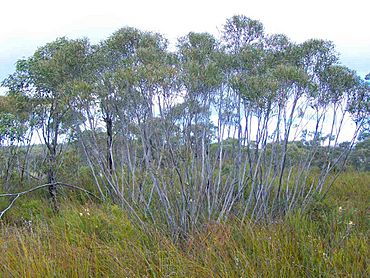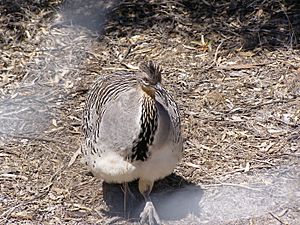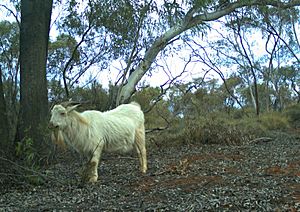Yathong Nature Reserve facts for kids
Quick facts for kids Yathong Nature ReserveNew South Wales |
|
|---|---|
|
IUCN Category Ia (Strict Nature Reserve)
|
|

Example of mallee vegetation
|
|
| Nearest town or city | Cobar |
| Established | April 1971 (NR); 1977 (MAB) |
| Area | 1,072.4 km2 (414.1 sq mi) |
| Managing authorities | NSW National Parks & Wildlife Service |
| Website | Yathong Nature Reserve |
| See also | Protected areas of New South Wales |
The Yathong Nature Reserve is a special protected area in New South Wales, eastern Australia. It's like a huge outdoor classroom, protecting nature and wildlife. This reserve is also known as a biosphere, which means it's recognized around the world by UNESCO for its unique environment.
The reserve was set up in 1971 and became a UNESCO Biosphere Reserve in 1977. It's super important because it has so many different kinds of native plants and animals. It also has a rich history, including past farming and cultural heritage.
Yathong Nature Reserve is one of the biggest protected areas in New South Wales. It's next to the Nonbinnie Nature Reserve and is part of a special area for birds called the Central NSW Mallee Important Bird Area. You can find this reserve about 130 kilometers (about 80 miles) south of Cobar and 656 kilometers (about 400 miles) west of Sydney.
Contents
Geography and Climate of Yathong Reserve
The land in Yathong Nature Reserve is mostly flat or gently rolling, with some ridges. It's a typical dry, or "semi-arid," area of central New South Wales. The reserve sits across two main natural regions: the Cobar Peneplain and the Murray Darling Depression.
The most noticeable land feature is the Merrimerriwa Range. This ridge system stretches through the southern part of the reserve. The soil here varies, from thin and rocky on the ridges to thicker, red, earthy types in the flatter areas.
The climate is hot and dry, which is normal for a semi-arid region. Summers are hot, and winters are mild. There's a steady amount of rain throughout the year, but it's still a dry place.
Amazing Plants and Animals
The Yathong Nature Reserve is a fantastic place for nature because of its different landscapes and climates. These features create many types of homes for plants and animals to live in. The mix of dry, semi-dry, and even some sub-tropical areas helps many different plant communities grow. This also means there's a wide variety of animals.
The main types of plants you'll see are dry woodlands, dry shrublands, and grassy woodlands. The animal life includes many mammals, birds, and reptiles. Some of these animals are rare or endangered, making the reserve even more important.
Diverse Plant Life
The reserve is home to many different plant species. There are 460 types of plants recorded here, and 12 of them are protected in New South Wales. Two plants, the curly-bark wattle (Acacia curranii) and wingless fissure-weed (Osteocarpum pentapterum), are especially important. One is vulnerable, and the other is extinct in the wild.
About half of the plants are "mallee" types. Mallee plants are a kind of eucalyptus that grow with many stems from the ground. Some examples include green mallee (Eucalyptus viridis), grey mallee (Eucalyptus morrisii), and red mallee (Eucalyptus socialis).
The other half of the plants are woodland types. These include white cypress pine (Callitris glaucophylla), bimble box (Eucalyptus populnea), and belah (Casuarina cristata).
In the past, farming and grazing changed the plant life in the reserve. It's hard to know exactly what the plant communities looked like before Europeans arrived. However, the large areas of untouched mallee plants in the reserve are very important for protecting these unique plants and the animals that live among them.
Wildlife and Bird Species
Yathong Nature Reserve is full of amazing animals, with 253 different species recorded. All of them are protected in New South Wales.
- Mammals: You might spot a short-beaked echidna (Tachyglossus aculeatus), a brush-tailed rock-wallaby (Petrogale penicillata), or a yellow-bellied sheathtail-bat (Saccolaimus flaviventris). The reserve is also home to three types of kangaroos: eastern grey (Macropus giganteus), western grey (Macropus fuliginosus), and red kangaroos (Macropus rufus).
- Reptiles: Many reptiles live here, too. Look for the marble-faced delma (Delma australis), western blue-tongued lizard (Tiliqua occipitalis), and mallee military dragon (Ctenophorus fordi). Many reptiles, like the malleefowl, prefer to live in the mallee plant areas.
- Birds: The reserve is a birdwatcher's paradise, with 130 confirmed bird species. A total of 162 bird species have been seen in the area. All recorded birds are protected in NSW, and 11 are protected nationally. Four species are recognized as nationally important. Some special birds include the malleefowl (Leipoa ocellata), red-lored whistler (Pachycephala rufogularis), grey falcon (Falco hypoleucos), pink cockatoo (Lophochroa leadbeateri), and striated grass wren (Amytornis striatus).
The malleefowl is a very special bird here. It needs a specific type of habitat, and human activities have made it harder for them to survive. The park has programs to help them breed and to protect them from predators. There's a national plan to help endangered species like the malleefowl. In NSW, they are working to control introduced animals, collect data, and monitor the malleefowl population to help them thrive.
Unfortunately, some introduced animals also live in the reserve. These animals can harm the native species. The main introduced animals are the European red fox (Vulpes vulpes), feral cats (Felis catus), feral dogs (Canis lupus familiaris), feral pigs (Sus scrofa), goats (Capra hircus), and rabbits (Oryctolagos cuniculus).
Challenges and Threats to the Reserve
The biggest natural danger to Yathong Nature Reserve is bushfire. Large fires can severely damage the plants and change the landscape. The NSW Government lists fire as a "Key Threatening Process" because it can destroy the natural structure and types of plants. The park has a fire management plan that considers both nature and cultural heritage. Because the reserve is so large and old, its plants are more resistant to drought and fire.
Another big problem comes from introduced animals. These animals hunt native species and compete with them for food. Feral dogs and cats are a threat to many animals, especially ground-nesting birds like the red-lored whistler, malleefowl, and striated grass wren. Goats and rabbits eat too much vegetation, which can harm both plants and animals. They also compete with native animals for food and destroy habitats. Even the three kangaroo species can cause problems by overgrazing and competing for resources.
Introduced plants, like lantana (Lantana camara) and bitou bush (Chrysanthemoides monilifera), are also a threat. They compete with native plants for space and resources. When these invasive plants spread, they can change the habitat and affect the native animals that depend on those plants.
Managing and Protecting Yathong Reserve
The NSW National Parks & Wildlife Service (NPWS) takes care of Yathong Nature Reserve. Their main goals are to protect the plants and animals, preserve the natural and cultural heritage, and allow people to visit responsibly.
They focus on managing both native and introduced plants and animals, as well as preventing and controlling fires. Another important part of their work is recognizing the cultural and historical importance of the park. The Ngiyam and Wiradjuripaa people, who are the traditional owners of this land, are involved in activities that protect cultural values and important sites. The NPWS learns from their knowledge to help manage the reserve.
Many groups are interested in helping the plants and animals of Yathong. The Foundation for National Parks and Wildlife (FNPW) helped create the reserve and continues to support conservation, especially for the malleefowl. The reserve is also listed in the Important Bird Area database, which helps monitor bird populations and plan future protection efforts.
To deal with threats, the NPWS has plans to control introduced species. They use baiting programs to target pests like foxes, feral dogs, and cats. These actions help protect the endangered and vulnerable native species in the reserve.





